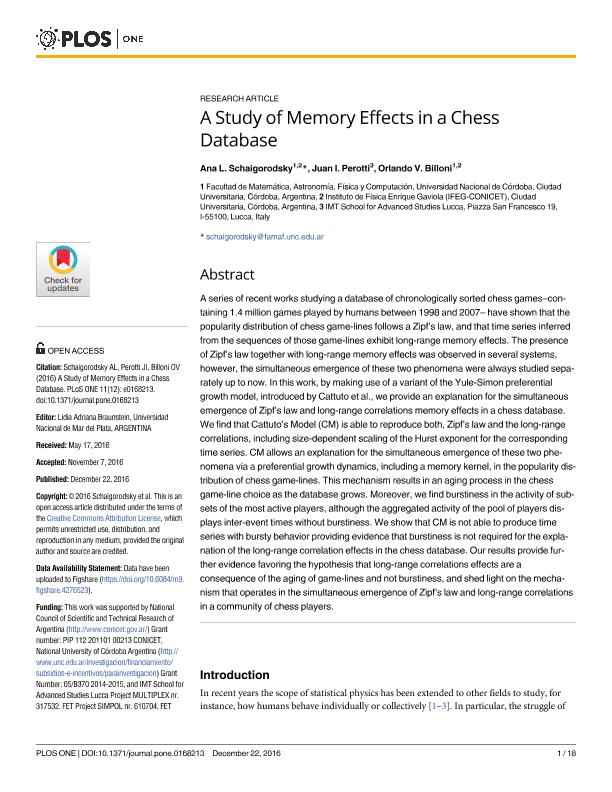Mostrar el registro sencillo del ítem
dc.contributor.author
Schaigorodsky, Ana Laura

dc.contributor.author
Perotti, Juan Ignacio

dc.contributor.author
Billoni, Orlando Vito

dc.date.available
2023-01-30T10:41:14Z
dc.date.issued
2016-12
dc.identifier.citation
Schaigorodsky, Ana Laura; Perotti, Juan Ignacio; Billoni, Orlando Vito; A Study of Memory Effects in a Chess Database; Public Library of Science; Plos One; 11; 12; 12-2016; 1-18
dc.identifier.issn
1932-6203
dc.identifier.uri
http://hdl.handle.net/11336/186028
dc.description.abstract
A series of recent works studying a database of chronologically sorted chess games-containing 1.4 million games played by humans between 1998 and 2007-have shown that the popularity distribution of chess game-lines follows a Zipf's law, and that time series inferred from the sequences of those game-lines exhibit long-range memory effects. The presence of Zipf's law together with long-range memory effects was observed in several systems, however, the simultaneous emergence of these two phenomena were always studied separately up to now. In this work, by making use of a variant of the Yule-Simon preferential growth model, introduced by Cattuto et al., we provide an explanation for the simultaneous emergence of Zipf's law and long-range correlations memory effects in a chess database. We find that Cattuto's Model (CM) is able to reproduce both, Zipf's law and the long-range correlations, including size-dependent scaling of the Hurst exponent for the corresponding time series. CM allows an explanation for the simultaneous emergence of these two phenomena via a preferential growth dynamics, including a memory kernel, in the popularity distribution of chess game-lines. This mechanism results in an aging process in the chess game-line choice as the database grows. Moreover, we find burstiness in the activity of subsets of the most active players, although the aggregated activity of the pool of players displays inter-event times without burstiness. We show that CM is not able to produce time series with bursty behavior providing evidence that burstiness is not required for the explanation of the long-range correlation effects in the chess database. Our results provide further evidence favoring the hypothesis that long-range correlations effects are a consequence of the aging of game-lines and not burstiness, and shed light on the mechanism that operates in the simultaneous emergence of Zipf's law and long-range correlations in a community of chess players.
dc.format
application/pdf
dc.language.iso
eng
dc.publisher
Public Library of Science

dc.rights
info:eu-repo/semantics/openAccess
dc.rights.uri
https://creativecommons.org/licenses/by-nc-sa/2.5/ar/
dc.subject
Zipf law
dc.subject
Long range memory
dc.subject
Burstiness
dc.subject.classification
Otras Ciencias Físicas

dc.subject.classification
Ciencias Físicas

dc.subject.classification
CIENCIAS NATURALES Y EXACTAS

dc.title
A Study of Memory Effects in a Chess Database
dc.type
info:eu-repo/semantics/article
dc.type
info:ar-repo/semantics/artículo
dc.type
info:eu-repo/semantics/publishedVersion
dc.date.updated
2023-01-27T16:36:50Z
dc.journal.volume
11
dc.journal.number
12
dc.journal.pagination
1-18
dc.journal.pais
Estados Unidos

dc.journal.ciudad
San Francisco
dc.description.fil
Fil: Schaigorodsky, Ana Laura. Consejo Nacional de Investigaciones Científicas y Técnicas. Centro Científico Tecnológico Conicet - Córdoba. Instituto de Física Enrique Gaviola. Universidad Nacional de Córdoba. Instituto de Física Enrique Gaviola; Argentina
dc.description.fil
Fil: Perotti, Juan Ignacio. Consejo Nacional de Investigaciones Científicas y Técnicas. Centro Científico Tecnológico Conicet - Córdoba. Instituto de Física Enrique Gaviola. Universidad Nacional de Córdoba. Instituto de Física Enrique Gaviola; Argentina
dc.description.fil
Fil: Billoni, Orlando Vito. Consejo Nacional de Investigaciones Científicas y Técnicas. Centro Científico Tecnológico Conicet - Córdoba. Instituto de Física Enrique Gaviola. Universidad Nacional de Córdoba. Instituto de Física Enrique Gaviola; Argentina
dc.journal.title
Plos One

dc.relation.alternativeid
info:eu-repo/semantics/altIdentifier/url/http://journals.plos.org/plosone/article?id=10.1371/journal.pone.0168213
dc.relation.alternativeid
info:eu-repo/semantics/altIdentifier/doi/http://dx.doi.org/10.1371/journal.pone.0168213
Archivos asociados
